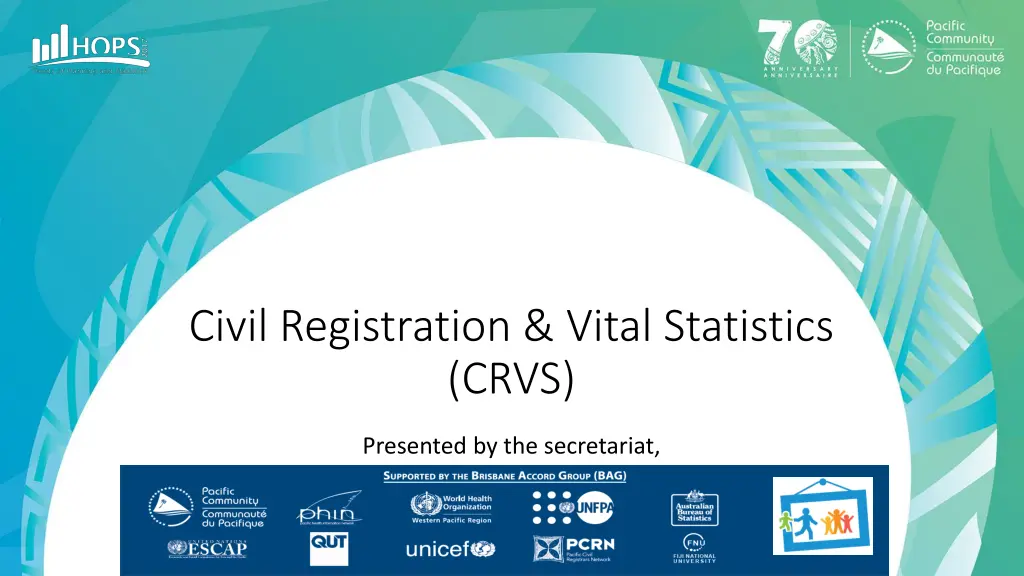
Understanding the Importance of Civil Registration and Vital Statistics
Exploring the significance of Civil Registration and Vital Statistics (CRVS) in recording vital events like births, deaths, and marriages. Learn how CRVS serves as a crucial tool for legal documentation, identity confirmation, and statistical data generation essential for development monitoring. Discover the role of CRVS in the Pacific region and its alignment with global development goals.
Download Presentation

Please find below an Image/Link to download the presentation.
The content on the website is provided AS IS for your information and personal use only. It may not be sold, licensed, or shared on other websites without obtaining consent from the author. If you encounter any issues during the download, it is possible that the publisher has removed the file from their server.
You are allowed to download the files provided on this website for personal or commercial use, subject to the condition that they are used lawfully. All files are the property of their respective owners.
The content on the website is provided AS IS for your information and personal use only. It may not be sold, licensed, or shared on other websites without obtaining consent from the author.
E N D
Presentation Transcript
Civil Registration & Vital Statistics (CRVS) Presented by the secretariat, on behalf of the Brisbane Accord Group
What is Civil Registration? Civil Registration: The continuous, permanent, compulsory and universal recording of the occurrence and characteristics of vital events, in accordance with the legal requirements in each country (UN, 2013) Vital events: important events in the life time of a person; Live births, deaths, marriages, divorces, foetal deaths, legitimization, recognition, annulment of marriage etc.
Why is Civil Registration important? Civil Registration (CR) serves two primary purposes: 1. The creation of legal records and documents: Used by individuals to identify themselves to each other and to the state and to claim their rights; Used by the state to confirm the identity of individuals and to facilitate service delivery Provide the primary feeder records for the establishment of important population databases such as national id, immigration, electoral databases etc. 2. The production of important statistics on life events (referred to as vital statistics); Needed for monitoring key demographic indicators
Vital statistics for development There are numerous national sources of VS. However, the UN recognizes CR as the most reliable sources of VS; and hence the acronym CRVS Key attributes of CR as sources of VS: 1. Continuity- able to provide critical fertility and mortality estimates at short term intervals (yearly and sub- yearly) and sub-nationally 2. Universality- Covers every member of the population 3. Permanence and cost-effectiveness do not require additional costs to implement except routine operational costs 4. Provide the most credible source of statistics on causes of death The SDG agenda underlines the need to expand the scope (periodicity and breadth) of reporting Monitoring of Goal 3 and Goal 16 of the SDGs directly relies on CRVS data on births, deaths and causes of death.
CRVS in the Pacific Development of CRVS systems is the region is guided by the Pacific Vital statistics Action plan (PVSAP), which sits under the Ten Year Pacific Statistics Strategy (TYPSS) The PVSAP is implemented through the collaborative effort of the Brisbane Accord Group (BAG) -a group of 10 partners, including UN agencies and universities: ABS, ESCAP, UNICEF, UNFPA, FNU, PhiN, PCRN, QUT, WHO, SPC (secretariat); The group seeks to build on the comparative advantage of each, maximise on resources, harmonise approaches and action at country level The PVSAP seeks to respond to Ministerial commitments made towards the Asia and Pacific Decade for Civil registration (2015-2024) and its corresponding monitoring framework In alignment to vision of the TYPSS, the overall aim is to strengthen the capacity of PICTs to produce and use quality vital statistics (on birth, death and causes of death) in support of development.
Key achievements PVSAP (2013-2017) 1. High level political commitment to CRVS by Pacific Ministers responsible for civil registration (2014)- though there are weaknesses in reporting against the Ministerial commitments with most countries having no reports Publication of the first set of vital statistics reports by 5 countries with 4 reports under review ; training provided to 12 countries Development of regional CRVS knowledge products: (http://www.pacific-crvs.org/ ) including regional best practice guideline on legislation for CRVS and IT for CRVS systems 2. 3. 4. 5. Legislation review in Vanuatu, Solomon Islands , Tonga Improved regional capacity in certification of causes of death through national and regional trainings (Samoa, Tuvalu) Cause of death coding through IRIS in Fiji and off-island coding support for Nauru Establishment of the PCRN: which has facilitated important data sharing arrangements Establishment of national CRVS coordination frameworks and development of national CRVS plans 6. 6. 7.
Key challenges in development of CRVS systems in the Pacific 1. Outdated Civil Registration legislation; 8 countries haven t revised their laws in the last 20 years. Inaccessibility to CR services due to direct and indirect costs of registration Difficulties in adoption of appropriate Information Technology (IT) in the context of a rapidly changing IT environment and numerous IT options Inadequate infrastructure for storage and archival of CR records and data: Inadequate disaster preparedness and mitigation measures Most countries haven't established mechanisms to routinely monitor completeness and quality of their systems Challenges in human resource capacity including staff number Data quality challenges especially for causes of death 2. 3. 4. 5. 6. 7. 8.
Priorities (2017-2021) 1. Strengthening national capacity on the : (i) analysis of CR data and report writing ; (ii) Certification of causes of death; and (iii) Coding of causes of death 2. Support in systems performance monitoring and reporting against Ministerial commitments 3. Support in CR systems strengthening based on specific country needs: legislation review, advocacy, coordination and national planning 4. Supporting platforms for peer-peer learning and knowledge sharing through south- south exchange visits, and regional workshops
You can find the documents mentioned and other materials at: http://www.pacific-crvs.org/docs Thank you!
